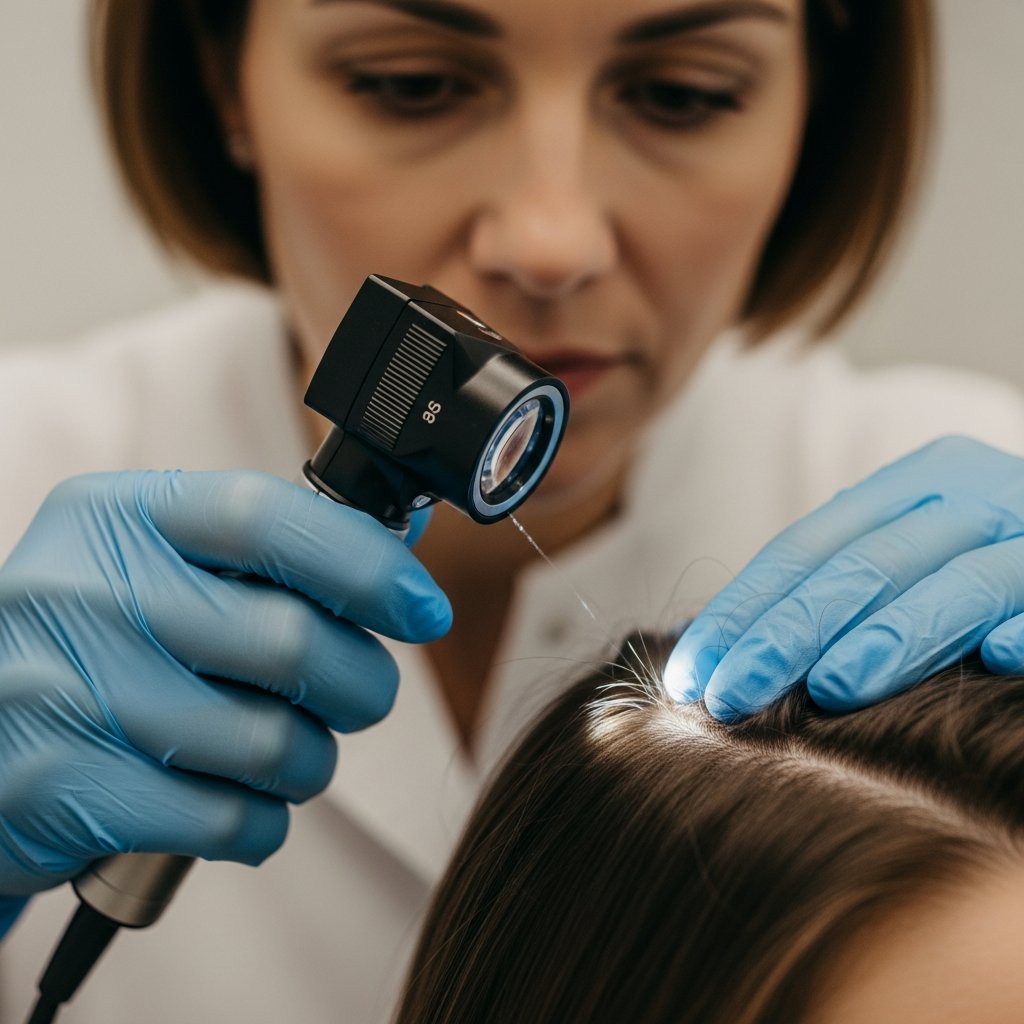Introduction: The Panic at the Drain
It is a scenario almost everyone has experienced: you are in the shower, rinsing out your conditioner, and as you pull your hands away, you see a clump of hair interlaced between your fingers. Or perhaps you are brushing your hair in the morning and notice that the bristles are accumulating hair much faster than usual. The immediate reaction is often panic. Is this normal? Are you going bald? Is it stress, diet, or something more serious?
Understanding the distinction between hair shedding vs. hair loss is crucial for maintaining both your hair health and your peace of mind. While the terms are often used interchangeably in casual conversation, they represent two very different biological processes. Shedding is a natural, necessary part of the hair growth cycle, whereas hair loss (alopecia) stops hair from growing effectively or causes it to fall out faster than it can be replaced.
In this comprehensive guide, we will demystify the science behind hair growth, explain exactly how much shedding is considered "normal," identify the red flags that signal true hair loss, and provide actionable advice on when to visit a professional stylist or a dermatologist.
The Biology of Hair: Understanding the Growth Cycle
To truly understand why hair falls out, one must first understand how it grows. Hair does not grow indefinitely; it cycles through distinct phases. Every single hair on your head is at a different stage of this cycle, which is why you don’t lose all your hair at once (like some animals that molt). The balance of these phases determines your overall hair volume.
1. The Anagen Phase (Growth)
This is the active phase where the cells in the root of the hair are dividing rapidly. A new hair is formed and pushes the club hair (a hair that has stopped growing or is no longer in the anagen phase) up the follicle and eventually out. At any given time, approximately 85% to 90% of the hair on your head is in the anagen phase. This phase can last anywhere from two to seven years, and the length of this phase determines how long your hair can grow.
2. The Catagen Phase (Transition)
Following the growth phase, the hair enters a short transitional stage known as the catagen phase. This lasts only about two to three weeks. During this time, hair growth stops, and the outer root sheath shrinks and attaches to the root of the hair. This is the formation of what is known as a club hair. Only about 1% of hairs are in this phase at any given time.
3. The Telogen Phase (Resting)
This is the resting phase, which typically lasts for about three months. During this time, the hair follicle is completely at rest, and the club hair is completely formed. Around 10% to 15% of hairs are in this stage. While the old hair is resting, a new hair begins the growth phase beneath it.
4. The Exogen Phase (Shedding)
This is the final part of the cycle, often considered an extension of the telogen phase. This is when the hair strand is released from the follicle and falls out. This is the hair you see in your shower drain or on your brush. Once the hair sheds, the follicle returns to the Anagen phase, and the cycle begins anew.
What is Normal Hair Shedding?
When discussing hair shedding vs. hair loss, it is vital to establish a baseline for normality. According to the American Academy of Dermatology, it is perfectly normal to lose between 50 and 100 hairs per day. For people with longer or thicker hair strands, this volume can look deceptively large, creating unnecessary alarm.
The "Wash Day" Phenomenon
One common misconception arises from wash frequency. If you wash your hair every day, you will likely see a consistent, small amount of hair in the drain. However, if you wash your hair only once or twice a week, the shed hairs from the previous days (which were trapped in your style or curls) are all released at once during the washing process. Seeing 300 hairs come out during a wash after four days of not washing is mathematically consistent with normal daily shedding, yet it looks terrifying visually.
Seasonal Shedding
Just like mammals that grow thicker coats in winter and shed them in spring, humans also experience seasonal shedding variations. Studies have shown that telogen rates (resting/shedding rates) are often highest in late summer and early autumn. If you notice slightly more hair in your brush during October or November, it is likely an evolutionary remnant known as seasonal shedding.
Defining True Hair Loss (Alopecia)
Unlike shedding, which is part of a renewal cycle, hair loss (medically termed alopecia) occurs when something stops the hair from growing. The medical term for excessive shedding is Telogen Effluvium, while the term for hair thinning or balding is Anagen Effluvium or Androgenetic Alopecia.
Anagen Effluvium
This type of hair loss affects hairs that are in the growth phase. It is most commonly associated with chemotherapy or radiation treatments. Since 90% of hairs are in the growth phase, this results in rapid and extensive hair loss, often affecting the entire body.
Androgenetic Alopecia
Also known as male or female pattern baldness, this is the most common cause of hair loss. It is genetic and involves the gradual miniaturization of the hair follicle. Over time, the growing phase becomes shorter, and the hairs produced become thinner and shorter until they eventually stop growing entirely.
Traction Alopecia
This is a form of hair loss caused by repeated pulling on the hair. It is common in people who frequently wear tight hairstyles like braids, ponytails, or extensions. If caught early, it is reversible; however, prolonged tension can cause permanent damage to the follicle.
Critical Differences: How to Tell Them Apart
Distinguishing between hair shedding vs. hair loss requires observation over time. Here are the key differentiators:
1. Visual Pattern vs. Overall Density
- Shedding: You will notice hair falling out, but the overall density of your ponytail or the coverage on your scalp remains largely the same. The volume is replaced as quickly as it is lost.
- Hair Loss: You may not see clumps falling out, but you will notice a gradual widening of the part line, a receding hairline, or a ponytail that feels significantly thinner than it did a year ago.
2. The White Bulb Test
- Shedding: Hairs that shed naturally usually have a small, white, club-shaped bulb at the root. This indicates the hair reached the telogen phase and fell out naturally.
- Hair Loss: If the hairs falling out do not have this bulb, or if they are breaking off mid-shaft, this indicates breakage or forced removal rather than natural shedding.
3. Duration and Triggers
- Shedding: Excessive shedding (Telogen Effluvium) is usually temporary and resolves on its own. It often starts 2-3 months after a specific trigger event (stress, illness).
- Hair Loss: True hair loss is often chronic and progressive. Without intervention, it tends to worsen over time rather than resolve.
Common Causes of Excessive Shedding (Telogen Effluvium)
If you are experiencing shedding well above the 100-hair mark, it is likely Telogen Effluvium. This condition pushes more follicles than usual into the resting phase. Common triggers include:
- Significant Weight Loss: Rapid dieting or caloric restriction can shock the body.
- Post-Partum Changes: During pregnancy, hormones keep hair in the growth phase. After birth, hormones normalize, causing all the "saved" hair to shed at once.
- High Stress: Severe emotional or physical stress (like a high fever or surgery) raises cortisol levels, disrupting the hair cycle.
- Nutritional Deficiencies: Lack of Iron, Vitamin D, or Zinc can force hair into the shedding phase.
When to Worry: Signs You Should See a Professional
While occasional shedding is normal, certain signs warrant a visit to a dermatologist or a trichologist-certified stylist.
1. Patchy Hair Loss
If hair is coming out in distinct round patches (Alopecia Areata) rather than generalized thinning, this is an autoimmune response that requires medical treatment.
2. Itching, Burning, or Redness
Normal shedding is painless. If your hair loss is accompanied by an inflamed, itchy, or painful scalp, you may be dealing with a fungal infection, psoriasis, or scarring alopecia.
3. Sudden, Massive Shedding
If you can gently pull a lock of hair and more than 10-15% of the strands come out easily without pain, you are experiencing active shedding that requires investigation into the root cause.
4. No Regrowth
If you shed hair but do not see short, wispy "baby hairs" appearing along your hairline or part line after a few months, the follicles may have stopped producing new strands.
Professional Solutions and Salon Treatments
Once you have determined whether you are dealing with shedding or loss, professional salons offer various services to help manage the aesthetic and health of the hair.
Scalp Facials and Exfoliation:
A healthy scalp is the bedrock of healthy hair. Salons offer scalp treatments that remove buildup (sebum, products, dead skin) which can block follicles and inhibit growth. These treatments often include massages to stimulate blood flow to the roots.
Volumizing Cuts and Color:
Experienced stylists can utilize specific cutting techniques to create the illusion of density. Blunt cuts make fine hair look thicker, while strategic highlighting can add dimension that disguises thinning areas.
Bond-Building Treatments:
For hair that is thinning due to breakage rather than follicle loss, bond-building treatments can reinforce the protein structure of the hair, preventing snap-off and preserving the length you have.
Tips for Minimizing Shedding and Supporting Growth
- Review Your Diet: Ensure you are getting enough protein (hair is made of keratin protein) and iron. Leafy greens, eggs, and lean meats are essential.
- Reduce Heat Styling: Excessive heat damages the hair shaft, leading to breakage that mimics hair loss. Always use a high-quality heat protectant.
- Manage Stress: Since stress is a primary trigger for Telogen Effluvium, incorporating yoga, meditation, or adequate sleep into your routine can physically impact hair retention.
- Be Gentle When Wet: Wet hair is at its most fragile. Avoid aggressive towel drying; instead, squeeze water out with a microfiber towel or old t-shirt.
- Silk Pillowcases: Reduces friction while you sleep, preventing nocturnal breakage.
FAQ: Common Questions About Hair Shedding
Q: Does brushing my hair more often cause more hair loss?
A: No. Brushing removes hair that has already shed from the follicle. However, aggressive brushing can cause breakage. Use a wide-tooth comb or a brush designed for detangling.
Q: Can coloring my hair cause hair loss?
A: Chemical processing affects the hair shaft, not the follicle (unless a chemical burn occurs). While bleach can cause breakage (making hair thinner), it typically does not cause true hair loss from the root unless there is an allergic reaction.
Q: Will cutting my hair make it grow back thicker?
A: This is a myth. Hair is dead tissue; cutting the ends does not affect the follicle at the scalp. However, cutting off straggly, thin ends makes the overall hair appearance look fuller and healthier.
Q: How long does post-COVID hair shedding last?
A: Many people experience shedding 2-3 months after a high fever or illness. This typically resolves on its own within 6 to 9 months as the body recovers.
Q: Are hair growth supplements effective?
A: They can be effective if the shedding is caused by a nutritional deficiency. However, if the hair loss is genetic or hormonal, vitamins alone will not stop the process. Consult a doctor before starting supplements.
Conclusion
Distinguishing between hair shedding vs. hair loss is the first step toward reclaiming control over your hair health. While seeing hair in the drain can be distressing, remember that shedding is often a temporary, natural response to life's stressors or simply the body renewing itself. However, when thinning becomes progressive or patterns change drastically, early intervention is key.
By maintaining a healthy lifestyle, treating your scalp with care, and consulting with professional stylists and medical experts when necessary, you can ensure your hair remains as healthy, vibrant, and full as possible. Do not let panic dictate your hair care routine—let knowledge guide you to the best solutions for your specific needs.
















